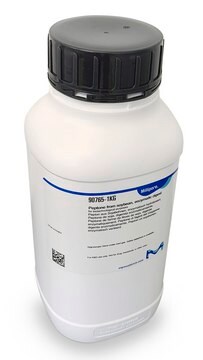추천 제품
product name
Peptone from casein, enzymatic digest, Enzymatic digest of casein, for biotechnological purposes
생물학적 소스
bovine milk
Quality Level
Grade
for biotechnological purposes
형태
powder
구성
total nitrogen (N), ~13%
질소 분석
, ~0.3 AN:TN ratio
무기 잔류물
<17%
손실
<6% loss on drying
pH
7.0±0.5 (2% in H2O)
solubility
H2O: 2%, clear, yellow to tan
water: soluble 2%, clear, faintly brown-yellow
응용 분야
food and beverages
microbiology
유사한 제품을 찾으십니까? 방문 제품 비교 안내
일반 설명
애플리케이션
Bacterial cultures for short term storage of bacteria.
The basal Glucose Yeast Peptone (GYP) medium.
As nitrogen supplement in the culture medium of Ceriporiopsis subvermispora.
Culture medium of Methylobacterium rhodesianum and Ralstonia eutropha.
Storage Class Code
11 - Combustible Solids
WGK
WGK 1
Flash Point (°F)
Not applicable
Flash Point (°C)
Not applicable
개인 보호 장비
Eyeshields, Gloves, type N95 (US)
문서
Culture media provides a habitat with suitable nutrients, energy sources, and certain environmental conditions for the growth of microorganisms. The components of the culture media range from simple sugars to peptones, salts, antibiotics, and complex indicators.
자사의 과학자팀은 생명 과학, 재료 과학, 화학 합성, 크로마토그래피, 분석 및 기타 많은 영역을 포함한 모든 과학 분야에 경험이 있습니다..
고객지원팀으로 연락바랍니다.







